Understanding, Testing for and Mitigating Radon
RAD-00760 View this publication in PDF form to print or download.
by Art Nash
What is radon?
Radon is a colorless, odorless, radioactive gas. It forms naturally from the radioactive decay of uranium, which is found at various levels in bedrock. Radon gas escapes upward through the soil from the bedrock below into the air, ground water and surface water. In the 1980s, geophysical surveying found that Alaska’s strongest natural concentrations are in the Yukon-Tanana uplands and parts of the Matanuska and Susitna valleys. These areas are generally underlain by schist bedrock, from which radon gas is released, but you will find radon anywhere there is decaying uranium with an escape route to the atmosphere.
Radon is present outdoors and indoors. It is normally found at very low levels in outdoor air and in drinking water from rivers and lakes because of dilution. However, it can be found at sustained, higher levels in the air of homes and other buildings, where it is contained.
Radon can enter a home through imperfections in the floors and walls when there is contact between the home and the soil. Examples include dirt-floor crawl spaces, unsealed sumps and cracks in slab-on-grade floors, utility penetrations and the tiny pore spaces in concrete block walls. In general, a basement provides a large surface area that contacts soil material, so it is a perfect place for radon to enter. Once it moves freely throughout the home’s indoor air, occupants breathe it into their lungs, where it can cause cell damage that may lead to lung cancer. The amount of radon in the air is measured in picocuries per liter of air. If you smoke and there are high levels of radon in your home, your risk of cancer is particularly high. Although there is no formula that tells you what your risk of cancer is based on length of exposure at certain levels, your risk of cancer increases over time in a home that has any level of radon. The Environmental Protection Agency (EPA) recommends taking action if the level of radon in your home is 4 picocuries per liter of air of higher.
Do I need to test for radon?
Though you can’t see radon, it’s not hard to find out if you have a radon problem in your home. Performing a radon test on your own is easy, inexpensive and can be done privately. Although you are not required under state law to test, if you do, you are required to disclose the findings if you sell your home. Many home inspectors hired by potential buyers, however, will ask for a test before closing on a house. If you need an immediate test, you can hire testing services with sophisticated equipment for dynamic readings that give a comprehensive understanding of radon levels over a 72-hour period. This can be especially helpful during home sales negotiations. However, a long-term test will give more useful information about continued exposure while living in the home year-round. Every home is unique because of the density of local soil, construction details, maintenance and the degree of internal pressurization, so the results of your next-door neighbor’s test cannot tell you if you have a radon problem. In addition, if you remodel, weatherize, change heating systems or even add an exhaust fan, the radon level in your home may change.
There are many kinds of low-cost, do-it-yourself radon test kits that you can get by mail and in some hardware stores and other retail outlets. Be sure to read the outside package before purchasing so that you know if there are any additional hidden costs for mailing the post-test sample to a lab for testing or for a lab fee for analysis. Testing is easy, doesn’t require any protective equipment or clothing and should take only a few minutes of your time. Since we spend most of our time indoors during the winter months here in Alaska, it is the best time to test.
Short-Term Testing
The quickest way to test is with a short-term test. Short-term tests remain in your home for two to 90 days, depending on the device. Charcoal canisters, alpha track detectors, electret ion chambers, continuous monitors and charcoal liquid scintillation detectors are most common. Because radon levels tend to vary from day to day and season to season, a short-term test is less likely than a long-term test to tell you your year-round average level. If you need results quickly, such as during an inspection of a pending home sale, a short-term test followed by a second short-term test may be useful.
Long-Term Testing
Long-term tests remain in your home for more than 90 days. Alpha track and electret ion chamber detectors are commonly used for this type of testing. A long-term test will give you a reading that is more likely to tell you your home’s year-round average radon level than a short-term test.
Follow the instructions that come with your test kit. Do not operate fans or other machines that bring in air from outside, although heating and air-conditioning system fans that recirculate air may be used. Fans that are part of a radon reduction system or small exhaust fans operating only for short periods of time may interfere with test outcomes.
The test kit should be placed in the lowest lived-in level of the home, for example, the basement if it is frequently used; otherwise, place it on the first floor. It should be put in a room that is used regularly (like a living room, playroom, den or bedroom) but not your kitchen or bathroom since high levels of moisture interfere with testing. Place the kit at least 20 inches above the floor in a location where it won’t be disturbed and where it is away from drafts, high heat, high humidity and exterior walls.
Leave the kit in place for as long as the package says, and once you’ve finished the test, reseal the package and send it to the lab specified on the package right away for analysis. Depending on the service, you can receive your test results by email within three days of the lab receiving your sample.
Some products may take several weeks.
A long-term test will give you a reading that is more likely to tell you your home’s year-round average radon level than a short-term test.
Since the level of radon is variable, a longer testing period is recommended, usually from three weeks to three months. Again, the test kit should be placed on the lowest frequently-used level of the home, about 20 inches above the floor. Be aware of where kids and pets may be during this prolonged period so they won’t interfere with the placement. Consider where you spend the most time and test in that room. For many of us, that is the bedroom. If your living patterns change and you begin occupying a lower level of your home (such as a basement), you should retest your home on that level.
Understanding your test results and taking action
The EPA recommends that you take action to reduce your home’s indoor radon level if it is 4 picocuries/ liter or more. While you can’t get rid of uranium under your house or change the soil your home has contact with, you can correct the problem by sealing or depressurizing your foundation. The cost of correcting a radon problem depends on how your home was built.
Methods to reduce radon include keeping the radon from entering the home and removing the radon once it is inside the home.
Start with the simplest changes and work up to the more complicated and expensive methods. Sealing cracks and other openings in the foundation is the simplest way to limit radon’s entrance into the house. Put a high-density plastic sheet (6 mil or thicker) on the ground, overlapping seams for complete coverage. Seal the sheet so there are no gaps where the air can leak into the crawl space or basement. In a cement slab basement, seal around the plumbing or electrical utilities that poke up through the floor. Use an acoustical sealant that never dries and a block filler to seal cracks.
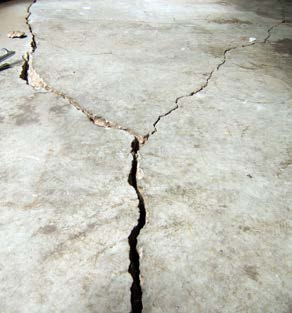
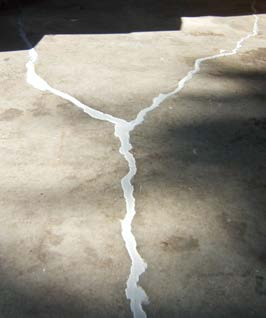
Next, reduce the negative pressure in your basement that allows radon-laden air to enter the home. If you have a forced-air combustion system in the basement or crawl space, make sure it is tuned up to prevent negative pressure. Make sure the system has a dedicated air supply from outside the basement.
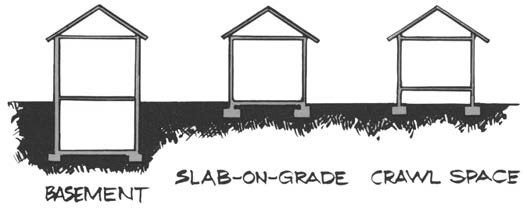
After sealing any cracks or holes and/or reducing the negative pressure in your basement or crawl space, test for radon again. If levels are still too high, consider looking into full mitigation.
When full mitigation is needed
If you cannot get your radon level below 4 picocuries/liter, you may need to use subslab depressurization. The kind of radon reduction system that will work best will depend on what kind of foundation your home has. Foundations generally used in Alaska are basement, slab-on-grade and crawl space. Your home may have a combination of these types of foundations. For instance, it is common to have a slab-on-grade foundation and a basement under part of the house. In this case, a combination of radon reduction systems is needed.
In houses that have a basement or a slab-on-grade foundation, radon can be reduced by subslab depressurization. One or more suction pipes are inserted through the floor slab into the crushed rock or soil and vented out of the house. Pipes can also be inserted below the concrete slab from outside the home. The number and location of suction pipes that are needed depends on how easily air can move below the slab and how much radon is present in the soil.
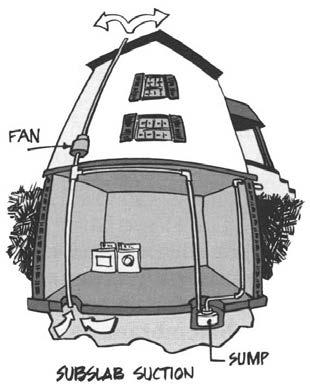 A radon vent fan is connected to the suction pipes to draw the radon gas from below
the home and release it into the outdoor air. In addition, the fan creates a negative
pressure or vacuum under the slab. In Alaska, a fan is necessary to depressurize the
slab because of the way slabs are constructed in our climate.
A radon vent fan is connected to the suction pipes to draw the radon gas from below
the home and release it into the outdoor air. In addition, the fan creates a negative
pressure or vacuum under the slab. In Alaska, a fan is necessary to depressurize the
slab because of the way slabs are constructed in our climate.
If your home has a crawl space, cover the exposed soil or gravel floor with a high-density plastic sheet and seal the sheet tightly to the wall. A vent pipe and fan are used to draw the radon from under the sheet and vent it to the outdoors. This is the most effective way to vent a home with a crawl space.
The vent pipe should be installed through the wall or the roof. Some pipes are vented through the roof with an ell and a second pipe placed horizontally to keep frost from building up and clogging the system. Exhaust pipes must vent above the surface of the roof, 10 feet or more above the ground and away from openings that could allow the radon to reenter the house.
The exhaust fan should be placed at the end of the pipe, which should be insulated to minimize the chance of condensed water freezing in the pipe, causing a blockage. The exhaust fan should not be located in or below a livable area; the best place to locate the fan is in the attic, outside or in the garage.
You should test your home again after installing the radon mitigation system to make sure the level of radon has been reduced.
Fan and vent installation recommendations for Alaska
The EPA recommends that the fan and vent pipe be located outside the building’s outer wall or roof; however, this design often does not work in Interior Alaska. This is because the moist air exiting from a depressurization system often causes hoar frost to develop on the inside of the vent pipe, which clogs the pipe and unbalances the fan, rendering the system useless.
According to certified radon mitigator John Ellison, ABC Inc., the best solution is to install the fan within the building, typically in a garage or crawlspace, and exit the vent to the outside horizontally, typically through a wall or rim joist, with most of the pipe inside the heated space. When installing a radon fan in a home, it becomes very important to seal the joints and all connections of the piping as well as the fan housing and the electrical connection to the fan. The idea is to prevent radon from “leaking” into the home if the fan quits operating, for example, during a power failure.
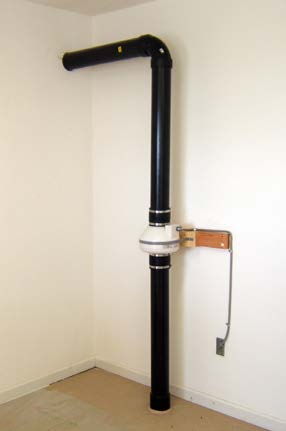 If you use a horizontal vent, be sure to maintain EPA guidelines in regard to windows,
doors and other openings in the building. Also, keep exterior piping to a minimum
to prevent freezeups in the pipe. If the pipe is installed vertically in a cold attic,
insulate around the pipe to the bottom of the roof deck. Do not decrease the size
of the pipe, which is typically 4-inch ABS or PVC. If the house has gable ends, it
may be possible to run the vent horizontally to a gable end. Slope the pipe to the
outside and bury it in the attic insulation; this will keep the pipe warm enough to
prevent condensation from forming inside the pipe and freezing it closed (condensation
will drain to the outside).
If you use a horizontal vent, be sure to maintain EPA guidelines in regard to windows,
doors and other openings in the building. Also, keep exterior piping to a minimum
to prevent freezeups in the pipe. If the pipe is installed vertically in a cold attic,
insulate around the pipe to the bottom of the roof deck. Do not decrease the size
of the pipe, which is typically 4-inch ABS or PVC. If the house has gable ends, it
may be possible to run the vent horizontally to a gable end. Slope the pipe to the
outside and bury it in the attic insulation; this will keep the pipe warm enough to
prevent condensation from forming inside the pipe and freezing it closed (condensation
will drain to the outside).
If you have any questions, call the Alaska Radon Hotline at 1-800-478-8324.
Art Nash, Extension Energy Specialist, and Roxie Rodgers Dinstel, former Extension Faculty, Health, Home and Family Development
Reviewed October 2024.
